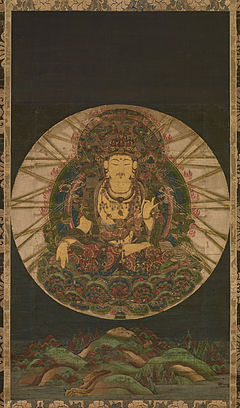Loading AI tools
Bodhisattva in Chinese, Japanese and Korean Buddhism From Wikipedia, the free encyclopedia
Ākāśagarbha (Chinese: 虛空藏菩薩; pinyin: Xūkōngzàng Púsà; Japanese pronunciation: Kokūzō Bosatsu; Korean: 허공장보살; romaja: Heogongjang Bosal; Vietnamese: Hư Không Tạng Bồ Tát, Standard Tibetan: Namkha'i Nyingpo) is a bodhisattva in Chinese, Japanese and Korean Buddhism who is associated with the great element (mahābhūta) of space (ākāśa).
| Ākāśagarbha | |
|---|---|
 Painting of Ākāśagarbha, Japan, 13th century | |
| Sanskrit | आकाशगर्भ
Ākāśagarbha गगनगञ्ज Gaganagañja |
| Chinese | (Traditional) 虛空藏菩薩 (Simplified) 虚空藏菩萨 (Pinyin: Xūkōngzàng Púsà) |
| Japanese | 虚空蔵菩薩
(romaji: Kokūzō Bosatsu) |
| Khmer | អាកាសគភ៌ (aa-kas-sak-koa) |
| Korean | 허공장보살
(RR: Heogongjang Bosal) |
| Tagalog | Akasagarbha |
| Thai | พระอากาศครรภโพธิสัตว์ |
| Tibetan | ནམ་མཁའི་སྙིང་པོ་ Wylie:nam mkha'i snying po THL: Namkhé Nyingpo |
| Vietnamese | Hư Không Tạng Bồ Tát |
| Information | |
| Venerated by | Mahāyāna, Vajrayāna |
Ākāśagarbha is regarded as one of the eight great bodhisattvas. His name can be translated as "boundless space treasury" or "void store" as his wisdom is said to be boundless as space itself. He is sometimes known as the twin brother of the "earth store" bodhisattva Kṣitigarbha, and is even briefly mentioned in the Kṣitigarbha Bodhisattva Pūrvapraṇidhāna Sūtra.
Associated with the qualities of Gautama Buddha, he is able to purify transgressions.
Kūkai, the founder of Shingon Buddhism, met a famous monk who is said to have repeatedly chanted a mantra of Ākāśagarbha as a young Buddhist acolyte. Kūkai took a tutorial with him on Kokuzou-Gumonji (a secret doctrine method, 虚空蔵求聞持法). As he chanted the mantra, he experienced a vision whereby Ākāśagarbha told him to go to Tang China to seek understanding of the Mahāvairocana Abhisaṃbodhi Sūtra.[1] Later he would go to China to learn Tangmi from Huiguo, and then go on to found the Shingon sect of esoteric Buddhism in Heian Japan.
There are several Mahāyāna sūtras in which Ākāśagarbha Bodhisattva is a central figure:
Additionally, he appears briefly in the final chapter of the Kṣitigarbha Bodhisattva Pūrvapraṇidhāna Sūtra, requesting the Buddha preach on the benefits of praising both the Sūtra and Kṣitigarbha.[2]
The Five Great Ākāśagarbhas are manifestation of the Five Wisdom Buddhas. They are said to bring about an increase of benefits such as good health. Within the traditional mandala, they are arranged as follows:

| Name | Direction | Color | Associated Buddha |
|---|---|---|---|
| Dharmadhātu Ākāśagarbha (法界虚空蔵) | Center | White | Vairocana |
| Vajradhātu Ākāśagarbha (金剛虚空蔵) | East | Blue | Akṣobhya |
| Ratnaprabha Ākāśagarbha (宝光虚空蔵) | South | Yellow | Ratnasambhava |
| Padma Ākāśagarbha (蓮華虚空蔵) | West | Red | Amitābha |
| Karma Ākāśagarbha (業用虚空蔵) | North | Black | Amoghasiddhi |
The mantra of Ākāśagarbha is believed to give rise to wisdom and creativity, and dispel ignorance.

The "morning star mantra" is a common mantra practiced in Shingon Buddhism. It is most often used as part of the Gumonjihō rite that is said to improve one's memory of the teachings and is derived from a sutra called Kokūzō Bosatsu nō man shogan saishō shin darani gumonji hō 虛空藏菩薩能滿諸願最勝心陀羅尼求聞持法 (Taishō Canon #1145). This mantra is:[3][4][5][6]
Seamless Wikipedia browsing. On steroids.
Every time you click a link to Wikipedia, Wiktionary or Wikiquote in your browser's search results, it will show the modern Wikiwand interface.
Wikiwand extension is a five stars, simple, with minimum permission required to keep your browsing private, safe and transparent.